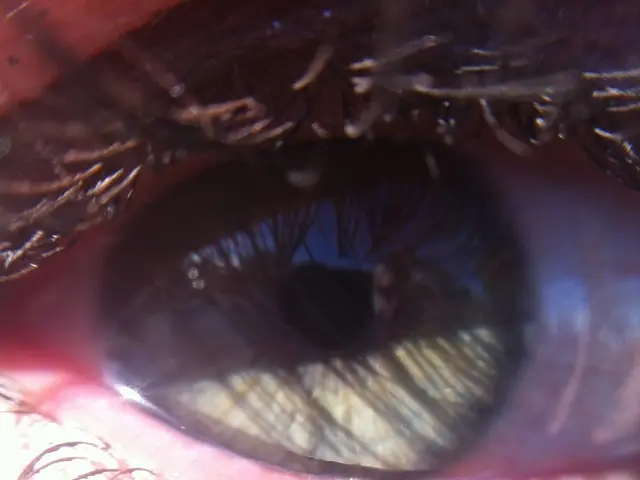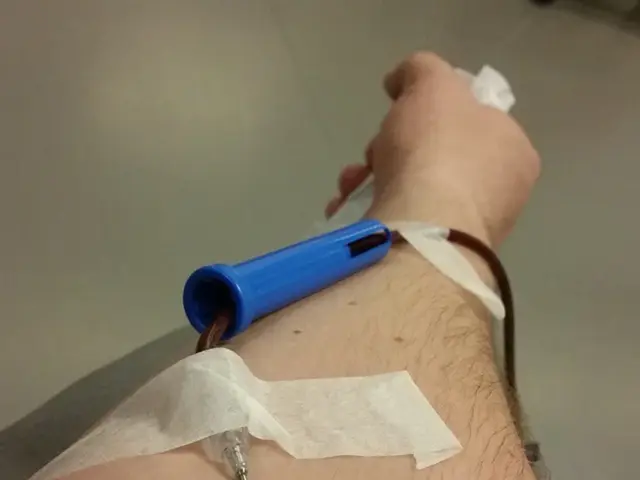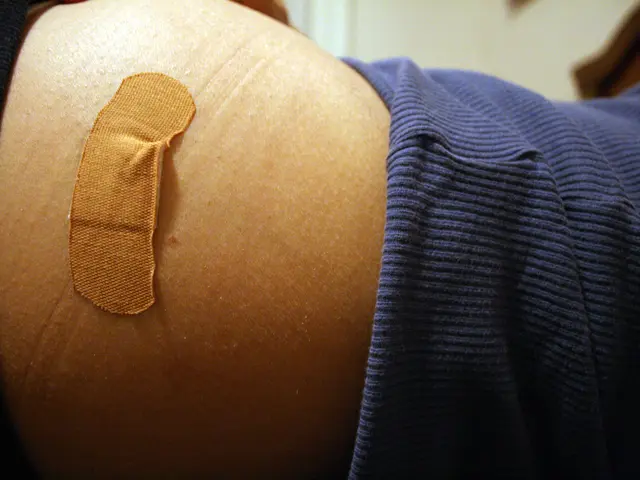Skin Irritation from Watch Bands: Identifying Culprits and Remedies
Watch problems got you down? Feeling like your fancy timepiece has morphed into an uncomfortable accessory because of annoying skin irritation? You're not alone, buddy! This pesky issue can transform everyone's favorite watch into a frustrating nuisance - no matter the watch type or band material. Whether you've noticed redness, itching, rashes, bumps, or other funky stuff where your watch touches your skin, learning about the culprits behind the chaos can help you nip the problem in the bud.
Now, pay attention, gramps, because we're diving deep into the root causes of this watch band drama. Keep in mind that constant skin contact with your watch band creates conditions unique to your body, which over time could lead to various skin reactions like a nasty rash. Don't be too surprised when a watch you've worn comfortably for years suddenly triggers an allergic response, as this is often due to cumulative exposure or changes in skin sensitivity.
Here's the lowdown on what's sowing the seeds of inflammation underneath your watch band:
- Metal Allergies: Yes, even gold!Are you shocked? Well, don't be surprised because nickel - a common allergen that affects up to 20% of the population - lurks in many stainless steel and, yep, white gold bands. That's right! Nickel can leach onto your skin through sweat, causing contact dermatitis - red, itchy patches that resemble the shape of the band.
- Chemical dodgies: You know those soaps, lotions, or detergents you slather on yourself daily? They can become trapped between your skin and watch band, creating a super concentrated irritant cocktail that weakens your skin barrier and leads to a foul form of irritant contact dermatitis.
- Sweat traps: Persistent dampness from trapped moisture and sweat provides an inviting environment for all sorts of funky bacteria and fungi. They party hard in warm weather or during exercise, potentially leading to yucky infections like folliculitis (infected hair follicles) or yeast infections.
- Leather woes: Bummer, right? The tanning agents and dyes used in leather watch bands contain chromium salts and other chemicals that can trigger allergic reactions similar to those caused by nickel allergies. Even worse, as these leather bands age or get wet, those compounds can super-leak onto your skin.
- Strangling bands: How 'bout those bands that are too tight and restrict air circulation? Nice pressure, right? Wrong! That tight fit leads to pressure-related irritation, impaired sweat evaporation, and even heat rash (miliaria) due to the inability of sweat to escape.
- Rubber ruination: Rubber accelerators and vulcanizing agents present in silicone and rubber bands can trigger irritation in overly sensitive individuals. These chemicals help with manufacturing but linger in the final product, sometimes causing delayed hypersensitivity reactions after extended exposure.
- Friction fever: Toss in some physical friction from watch bands that slide against your skin during daily activities. Boom! Micro-abrasions on your skin's surface become the perfect texture for gathering more sweat and grime. Micro-abrasions combined with sweat can create even more irritation over time.
The weight of the world is now on your wrist, but don't give up hope, friend! Watch irritation usually stems from a mix of overlapping factors rather than a single villain. Identifying the specific causes behind your skin's misery will help you devise more effective solutions to save the day (or at least your wrist).
Time to talk turkey: Let's figure out what's making your skin dance the cha-cha instead of the cha-ching! Are you ready to rock and roll?
Signs and Symptoms of Watch Band-Related Woes
Catching the problem early keeps the inflammation from escalating into something more serious. You know the drill - pay close attention to patterns on your skin because it's important to be able to differentiate between the types of irritation. Word to the wise: Being able to identify various skin woes helps you pinpoint the cause and find apt solutions before the irritation bloodies your battlefield.
Here's a quick rundown of the most common signs and symptoms:
- Contact Dermatitis: Appears as red, itchy, and sometimes scaly patches that precisely match the shape of your watch band. Allergic contact dermatitis tends to appear 12-48 hours after exposure and can spread beyond the contact area as the immune system responds, while irritant contact dermatitis remains confined to the exact contact area.
- Heat Rash (Miliaria): Shows up as small, red bumps or clear, fluid-filled blisters in areas where sweat becomes trapped under the watch band. This displeasure occurs when sweat ducts become blocked, commonly during hot, humid weather or after intense physical activity while wearing a watch that doesn't allow your skin to breathe.
- Persistent Pressure Marks: Your skin cries "uncle" when those pressure marks won't fade within 30 minutes of removing your watch. Indicates the band is too tight, causing circulation issues and potentially leading to skin breakdown if the pressure persists over time.
- Discoloration: Green or black skin discoloration beneath metal watch bands occurs when acids in your sweat react with copper alloys in the metal. While not necessarily harmful, this staining (known as "verdigris" when green) indicates that metal components are corroding and may be releasing more potential allergens onto your skin.
- Folliculitis: Bacterial infection that appears as small, pus-filled bumps resembling acne when huddled around watch contact areas, right where hair follicles reside.
- Lichenification: Thickening and hardening of the skin develops after repeated irritation on your part (scratching, rubbing, etc.). This defensive reaction of the skin results in leathery patches with exaggerated skin lines, indicating chronic irritation that has persisted for weeks or months.
Each symptom manifests with varying severity, depending on your skin type, sensitivity level, and the specific irritant involved. Pay attention to when your skin starts reacting, as this can provide valuable clues about the cause. Most symptoms disappear within a few days of removing the offending watch band, but more severe reactions might take a bit longer to heal completely. Persistent symptoms might warrant a visit to a healthcare provider, or a complete change in watch band materials.
Solutions for Happy Skin on Your Wrist
The key to happiness lies in understanding both the cause of irritation and the specific watch band material causing boo-boos. Each material requires a different approach to minimize skin reactions. Think of it like this - one-size-fits-all doesn't always work when it comes to watch bands!
- Metal Band Allergies: Find hypoallergenic alternatives like pure titanium (Grade 1 or 2), high-grade stainless steel (316L or higher), or ceramic bands containing minimal or no nickel. Some metal bands come with protective barriers, like proper plating or PVD (Physical Vapor Deposition) coatings, that create an effective barrier between your skin and any potential allergens.
- Leather Conundrums: Swap leather bands contaminated with chromium salts and other allergens for vegetable-tanned leather or consider specially treated hypoallergenic leather bands designed specifically for sensitive skin.
- Silicone and Rubber Issues: Experiment with medical-grade silicone bands undergoing rigorous testing for biocompatibility or opt for brands marketing hypoallergenic rubber alternatives sporting different manufacturing processes that eliminate common irritants and accelerators.
- Nylon and Fabric Dilemmas: Choose breathable alternatives that reduce moisture buildup, but make sure to wash them regularly to prevent bacterial growth and the accumulation of sweat salts. Opt for machine-washable options without dyes that might trigger additional irritation.
- Band Liners and Barriers: Embrace protective thin films made of hypoallergenic materials that create distance between your skin and the irritating material - while preserving the appearance of your original band - reducing direct contact with potential allergens.
- Nail Polish Ninjutsu: Applying unscented, clear nail polish to the back of metal watch components can create an imperfect but effective temporary barrier against direct contact with metals. You'll need to reapply it periodically, but it can vote-face the odds against metal exposure.
- Watch Band Smooth Operator: Keep things interesting by regularly switching your watch bands made from different materials to give irritated skin time to heal. The Oxford comma doesn't apply here, but the benefits of variety certainly do!
Stay saucy! Keep in mind that even after switching to a more compatible material, good care habits are essential to prevent irritation from other factors like moisture or bacteria. The best solution often combines choosing appropriate materials with implementing good watch-wearing practices. Don't get discouraged if your first attempt doesn't totally solve the problem - finding the ideal mix of materials and practices is sometimes a trial-and-error endeavor.
Keep Your Watch Band Babies Happy
Now that we've chatted about how to treat the grumps, it's time to talk about keeping irritation at bay before it rears its ugly head! Keep these tips in your back pocket, and your watch band will never ditch you during a Tinder date or job interview again. Bonus: Happy skin equals fewer trips to the doctor, fewer prescriptions, and more cash in your wallet.
- Clean freak: Ensure that your watch band gets thoroughly scrubbed down at least once a week with mild soap and water. Different materials require special cleaners - metal bands may appreciate the occasional alcohol wipe along with soap and water, while leather bands need specially formulated leather cleaners or risk damage.
- Proper Fit: Nail the perfect size! Wearing the proper size watch band allows for airflow, reduces direct contact, and prevents excessive friction. The "one-finger rule" (you should be able to slide one finger between your wrist and the watch band comfortably) ensures a fitting fit. Too tight can lead to bacteria and fungi overgrowth, while too loose can create excessive friction as the watch bands slide around your wrist.
- Airing Out: Give your skin a break every day for at least 1-2 hours by removing your watch (unless you're engineering a nuclear missile or battling a serpent monster). Giving your skin a chance to breathe, dry, and heal is essential in maintaining healthy skin - even if you're prone to allergies.
- No Sweat: Sweat can be ruthless, so keep your watch band dry by thoroughly drying your wrist before putting your watch back on after showering, washing your hands, or participating in activities that cause sweat - like long hikes, tough workouts, or a heated debate with your significant other.
- Moisture Barrier: Secure a protective shield by slathering unscented, hypoallergenic moisturizers around your wrist 30 minutes before putting on your watch. This strengthens your natural protective barrier while hydrating your skin - a win-win!
- Bah Humbug to Sweat Festivals: Limit watch-wearing during activities that increase sweating, such as sweaty workouts, saunas, hot yoga, or sunbathing. When you must wear it, clean both your wrist and watch band immediately afterward.
- Hypoallergenic Spell: Consider hiring a professional to apply medical-grade barriers to your watch band, especially for pricey or sentimental pieces that you'd rather not replace.
Can you feel that warm, fuzzy feeling of watch band happiness sweeping over you? Employing these tactics together creates a comprehensive prevention strategy, leaving you with happy skin and the timepiece game on lock. Keep in mind that even hypoallergenic materials require routine care to prevent irritation from other factors, so don't neglect these preventive strategies. Your wallet will thank you, and your watch band will never betray you again!
Band-Aids for Watch Band Woes: When it's Time to Call the Doc
While most watch band irritation vanishes with self-care and careful material choices, some situations warrant a visit to a healthcare provider to nip any serious complications in the bud. Recognizing when to seek professional help ensures that more serious skin problems don't develop from watch irritation. A dermatologist can provide solutions tailored to your unique situation.
- Severe allergic reactions: Widespread rash beyond the watch contact area, significant swelling, blistering, or extreme discomfort demand prompt medical evaluation. These symptoms may indicate a more serious allergic response that requires professional attention before conditioning worsens without intervention.
- Signs of infection: Increasing redness, warmth, pain, swelling, yellow or green discharge, or red streaks extending from the irritated area. Bacteria can enter through damaged skin, potentially causing cellulitis or other infections.
- Persistent irritation: Irritation that doesn't improve after preventing watch contact for 1-2 weeks might indicate an underlying condition such as eczema or psoriasis, or continued exposure to an unidentified allergen.
- Recurring problems: If you've tried multiple materials, preventative strategies, orchg feedback failed to quell the problem, your band may be triggering an underlying condition that requires medical intervention.
- Medical uncertainty: If you're unsure of the cause of your skin reaction, consult a dermatologist who can perform patch tests to pinpoint exact allergens. This diagnostic procedure can help you make wise material choices in the future.
- Unusual Skin Changes: Persistent discoloration, unusual texture, or non-healing areas should be evaluated professionally as these symptoms might indicate rare complications or unrelated skin conditions hidden in the watch-wearing area.
- Science and health-and-wellness go hand in hand as understanding the causes of watch band-related skin irritation helps promote healthy wrists.
- Fitness-and-exercise is a significant factor in watch irritation, as excessive sweating provides an environment for harmful bacteria and fungi to grow.
- Skin-care practices play a crucial role in preventing watch band irritation, and proper care habits can help reduce irritation from other factors like moisture or bacteria.








